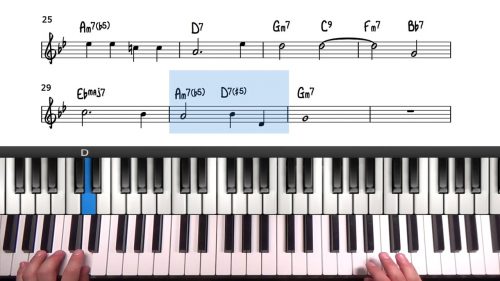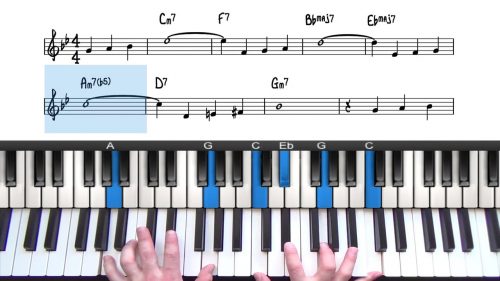Piano Accompaniment Techniques: Adding Fills
Welcome to this lesson on adding fills when accompanying singers. So far we have covered the fundamental skills and requirements when accompanying a vocalist. We’re now going to take things a step further and explore other aspects of the performance.
We’ll continue to use the tune "Autumn Leaves" in G minor as our sample song and explore the different types of fills which are:
- Arpeggio Fills
- Scale Fills
- Modal Fills
- Bluesy Fills
- Comping Fills
- Bassline Fills
Filling In The Spaces When Accompanying A Singer
Before the performance, you should identify the places where the melody is static. These points in the melody, where the singer is either holding a sustained note, or takings a breath, is a great place to add in decorative touches to complete the sound – just as you would when playing solo piano.
If we analyse the form of "Autumn Leaves", measure 2, 4, 6, and 8 are good examples of these spaces.
Comping Rhythms When Accompanying Singer
Another great way to fill the melodic space is through comping rhythms. In your left hand you can keep your voicings strictly to the pillars – 1, 3, 5 and 7, and in root position. You can experiment with different inversions in the right hand and add more complexity through the rhythmic figures by using anticipation and syncopation. We’ll demonstrate this using the form of "Autumn Leaves".
Practice Tips
-
Outline your breaks in melody, the places where you'll get to play around with licks, colours, extension and rhythm.
-
Knowing how to play clean and simple should be your default. Only Stepping into fills when things are rolling well with your singer.
-
With any of the techniques covered in this lesson, you should use with caution. It will depend on the singer, how well they know the song, and even what kind of day it is!
- Rehearsing with yourself singing or with your singer is a great way to experiment with these techniques and find what will work for you.







Hello lyndol/hayden, só we can add chord extensions when we play with a singer but only in the moments that we use fills? Because in the last lesson i learned that less is more when playing with a Singer.
It is posible to be capable of improvising with all these concepts from nothing?Or there is always some type of arragment that is trained with a little bit of time?Olso how about the use of voicings like the kenny voicing or só what voicing?They can still be applied in fills with a Singer?Thanks
The main things here Ivan is to choose your moment carefully to add fills. You do not want to detract from the singers performance.
Lyndol recommends that you identify the breaks in the melody before hand, and perhaps practice a few ideas. Ultimately, your ideas and fills must support the singer.
Absolutely, you can use any type of voicings, but one thing to be careful of, is that those voicings contain upper extensions (9s and 11s) and Lyndol recommends that you stick to the ‘pillars of chord’ which is the 1-3-5-7 … when there is a break in the melody, that is the time to introduce the extensions, and alterations.
Remember…. start simple, and then gradually add in extensions and alterations. That way you are building your knowledge step by step, and not running before you can walk.
Finally, experiment Ivan…. much can be discovered through experimenting and thinking “what if I played this here….” etc…
Hope this helps,
Hayden
Ok understood.Thks for the reply